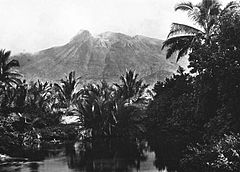| 1871 Ruang eruption and tsunami | |
|---|---|
 | |
| Volcano | Mount Ruang |
| Start date | March 3, 1871 |
| End date | March 14, 1871 |
| Location | Sangihe Islands, Molucca Sea |
| VEI | 2 |
| Deaths | 416 |
The 1871 Ruang eruption began on March 3, and ended on March 14 at the Ruang volcano in the Molucca Sea, Indonesia. The eruption triggered a locally devastating tsunami measuring 25 m (82 ft). It flooded many villages on nearby islands, killing some 400 people.
Eruption
The eruption on March 3 began when volcanic materials began falling from the summit and into the sea. German zoologist and anthropologist Dr. Adolf Bernhard Meyer, an eyewitness to the eruption described Ruang as a conical island rising above the sea. At the time of the eruption, the island was uninhabited. The residents of nearby Tagulandang island however, owned plantations on Ruang island. A strong earthquake and loud rumbling sound occurred at 20:00 local time. Based on examining historical observations of the eruption, Pranantyo and others interpreted it as the partial collapse of the eastern volcanic flank. Simulation of a flank collapse and the triggered tsunami indicate the volume of the slide at 0.1 km (0.024 cu mi) best fit the historical descriptions of the tsunami heights on nearby islands. The Global Volcanism Program at the Smithsonian Institution assigned the eruption Level 2 on the volcanic explosivity index (VEI). Eruptions continued on March 9–10 and 14.
Tsunami
According to Dr. Meyer, the tsunami caused extreme devastation on Tagulandang island, located next to Ruang, very few homes survived the tsunami. Waves of up to 25 m (82 ft) swept into the seaside settlements, and inundated 180 m (590 ft) inland. Two additional tsunami waves struck the coast shortly after. The tsunami destroyed the village of Bahhuas; at least 75 homes were destroyed. Three homes remained at the coast but only one was safe for use; the two other homes suffered major damage. Many homes were overturned or obliterated. A church on the island with thick exterior walls was also demolished. Debris of homes were deposited all over the former settlement.
See also
- 1741 eruption of Oshima–Ōshima and the Kampo tsunami
- 1888 Ritter Island eruption and tsunami
- 2018 Sunda Strait tsunami
- 2022 Hunga Tonga–Hunga Haʻapai eruption and tsunami
- List of tsunamis
- List of volcanic eruptions by death toll
References
- Ignatius R. Pranantyo; Mohammad Heidarzadeh; Phil R. Cummins (2021). "Complex tsunami hazards in eastern Indonesia from seismic and non-seismic sources: Deterministic modelling based on historical and modern data" (PDF). Geoscience Letters. 8 (8): 20. Bibcode:2021GSL.....8...20P. doi:10.1186/s40562-021-00190-y. S2CID 233746800.
- "Ruang". Global Volcanism Program. Smithsonian Institution. Retrieved 2022-01-23.
- ^ "Significant Volcanic Eruption". ngdc.noaa.gov. NOAA National Centers for Environmental Information. Retrieved 23 January 2022.
- Rowley, G. D. (1877). Ornithological Miscellany. Vol. 2. London: Taylor and Francis. pp. 324–325.
- "Tsunami Event Information". earthquake.usgs.gov. NOAA National Centers for Environmental Information. Retrieved 23 January 2022.
| Volcanic eruptions in Indonesia | |
|---|---|
| Before 1800 | |
| 19th & 20th century |
|
| 21st century |
|